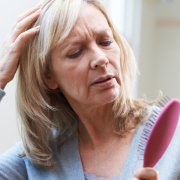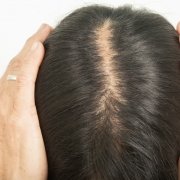What Are the Main Causes of Alopecia?
The definition of alopecia is hair loss. It can affect just the scalp or the entire body, and it can show up as pattern baldness, patches of bald spots, or sudden hair loss that may gradually grow back again.
There are many reasons why people experience various types of alopecia. Let’s take a look at some of the most common causes of hair loss and who you can talk to about treatment that would work for you.
Causes of Hair Loss
A healthy adult loses about 100 hairs each day. Normally this doesn’t cause any noticeable effects, because new hair is constantly growing in and growing longer.
There are a handful of causes that are often to blame for a person’s hair loss, including the following:
Family History
The most common cause of hair loss is if you have inherited a genetic predisposition to lose your hair in a certain way. This is called male pattern baldness or female pattern baldness.
This type of hair loss occurs with age – even as early as the 20s – and in certain predictable patterns. Men may lose their hair at the crown of their head and/or in an “M” shape with a widow’s peak, while women’s hair tends to thin out especially along where they part their hair.
Health Conditions
Many conditions such as pregnancy, childbirth, menopause/andropause, and thyroid issues can all cause alopecia. Contracting ringworm can cause patches of hair loss.
Hair loss is often distinguished in the following ways:
- Alopecia areata is an autoimmune disorder that causes hair loss in patches.
- Alopecia totalis is when a person loses all the hair on their scalp, including eyebrows and eyelashes.
- Alopecia universalis is when a person loses all the hair on their body.
Medications and Supplements
A side effect of chemotherapy, which is often used to fight cancer, is that it can cause complete hair loss. This is also true of certain medications that are used to treat arthritis, heart problems, high blood pressure, and some antidepressants.
Radiation therapy, especially when directed toward the head, may cause permanent changes to the hair follicles. When the treatments cease, the hair may grow back very differently than how it was before. Patients often report that the hair grows back with a coarser texture and in a different color; some patients’ hair may not grow back. Your hair restoration doctor can evaluate your condition and give you advice about what you can do about your hair.
Stress
After experiencing a tremendous emotional or physical shock, you may notice hair coming out in clumps in the shower. This type of alopecia is usually a temporary condition.
Hairstyles or Hair Treatments
Styles that pull the hair tightly, such as braids, cornrows, or pigtails, can result in traction alopecia. Similarly, hot oil treatments or excessive permanents can cause inflammation and scarring of the hair follicle. If the follicle becomes badly damaged from treatments or traction, the hair loss will be permanent.
Hair Restoration Doctor in Kansas City, MO
If you have started losing your hair and you want to save it, speak to our hair loss and treatment physician at Darling Hair Restoration. Dr. Scott Darling has years of experience in successfully restoring patients’ hair, and he offers many different treatment options.
If you have any questions or would like to schedule a consultation with Dr. Darling, contact our friendly staff today by calling us at (816) 792-3400 or by filling out our appointment form online now. We look forward to helping you get your “look” back!










